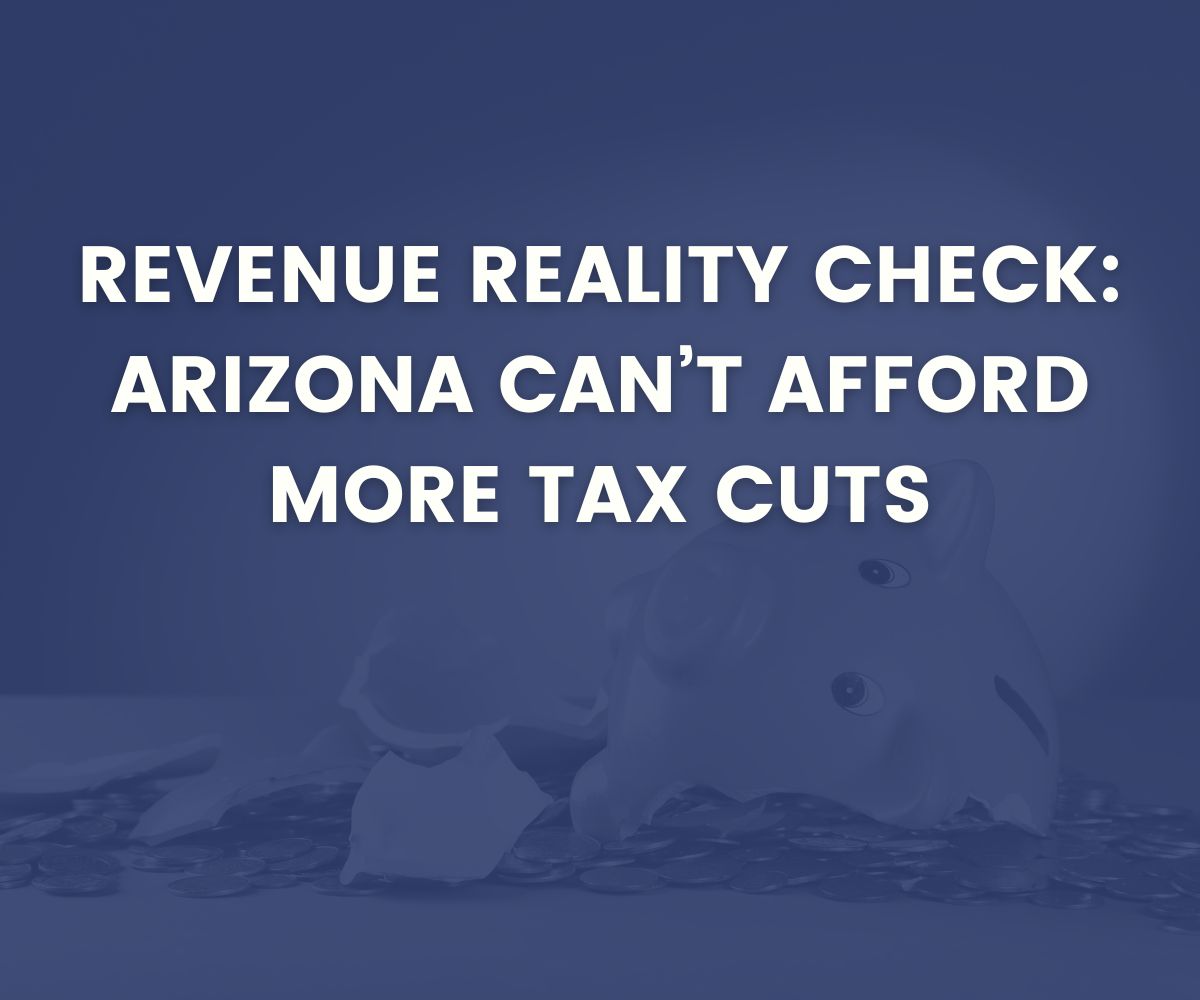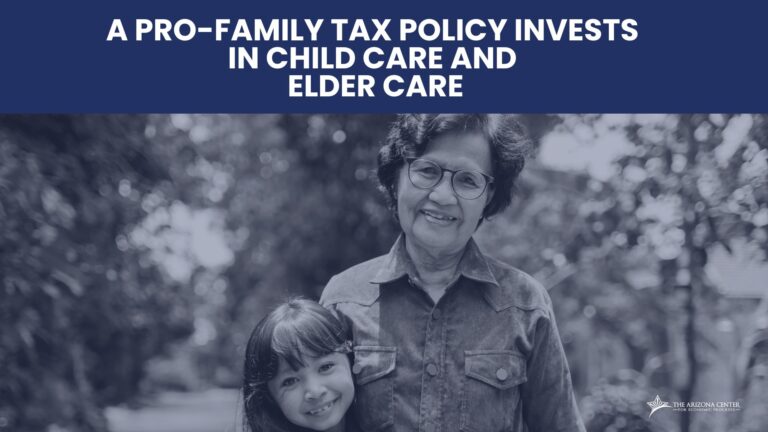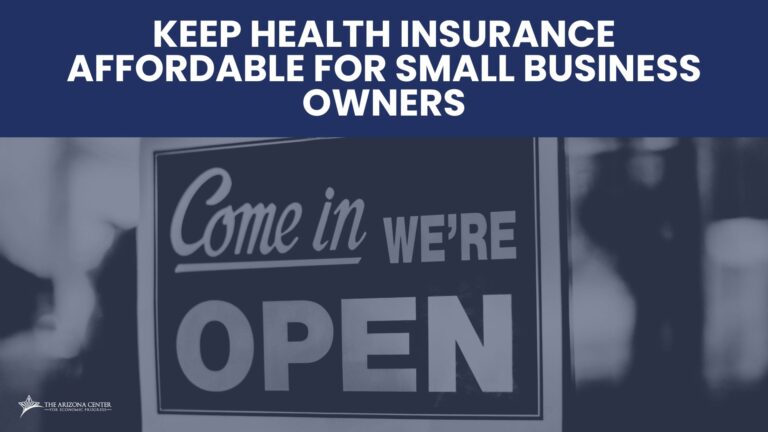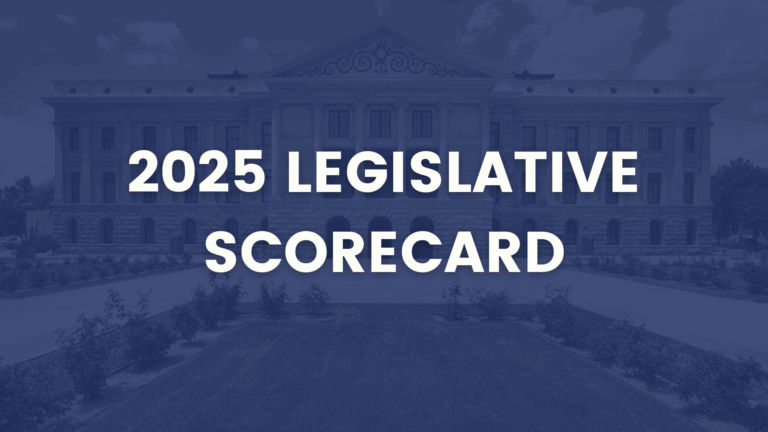
REVENUE UPDATE: WE CANNOT AFFORD ANY MORE TAX CUTS
Last month, the Joint Legislative Budget Committee (JLBC) presented its fiscal year 2026 (FY2026) baseline and revenue forecast at their January Financial Advisory Committee (FAC) meeting.
What is the JLBC baseline?
The JLBC baseline sets the starting point for the next budget by:
- Deleting one-time expenses from prior year (except those under agreements)
- Updating statutory and other funding formula changes like those for K-12 education, AHCCCS/Medicaid and Community Colleges.
Baseline spending adjustments include:
Fiscal Year 2025
Supplemental Adjustments
- $104 million for K-12 education basic state aid
- $76 million for higher Division for Developmental Disabilities (DDD) healthcare rates
Fiscal Year 2026
Formula Increases
- $596 million for K-12 education basic state aid which includes:
- $286 million to backfill loss of Prop 123 land trust funding
- $180 million for Empowerment Scholarship Accounts (ESA) growth cost for additional 9,000 students
$382 million for AHCCCS/Medicaid formula adjustments which includes:
- $262.5 million for DDD health care growth
One-time Item Removals
Including the following priorities:
- $3.8 million for waiving the reduced-price fee for school meals
- $12 million for child care assistance
- $15 million for Housing Trust Fund
- $37 million for Opportunity Weight funding in K-12 education formula for students with low-income
- $12.5 million for Healthy Families Program, an in-home visiting program that helps reduce Department of Child Safety (DCS) involvement for at-risk families
The graph below shows JLBC’s baseline balance three-year projections for fiscal years 2025 through 2028. Normally, the cash balance (difference between revenues and expenditures) from one year is carried forward to the next year. This year’s baseline assumes we will spend all funds and therefore, not have money to carry forward in fiscal years 2027 and 2028.
Unlike the $1.7 billion shortfall last year, our baseline cash balances this year appear to be surpluses. In fact, the JLBC projected baseline cash balance for FY2026 is $935 million.
But do we actually have $1 billion to spend this year?
One expense not included in JLBC’s projected balance is traditional one-time “ongoing” funding for items that we have normally included in our budget for the last five years.
There are two traditional one-time “ongoing” expenses:
- K-12 education building renewal, currently estimated at $183 million
- State Employee Health Insurance Trust Fund subsidy, currently estimated at $140 million
If the $323 million cost for these two traditional one-time “ongoing” items are included in budget projections, our cash balances would look less positive. The graph below shows what our cash balances would be if we include these two traditional one-time “ongoing” items and do not have new expenses this year. This reduces the $935 million cash balance to $612 million for FY2026 – meaning we may actually have about a third less to spend.
In addition, JLBC recommends leaving an ending balance of at least $50 million. This lowers the $612 million further to $560 million for new expenses. The $560 million could all be spent on one-time funding items or be split into not more than $125 million for ongoing items and $435 million for one-time items to keep an ongoing positive balance in later years.
If lawmakers elect to spend all $612 million funds for FY2026 and account for traditional one-time “ongoing” funding items in future years, in the graph below we calculate budget deficits in fiscal years 2027 and 2028.
Don’t forget we failed to fund budget obligations, delayed costs, and cut agency budgets and programs last year – at a time of strong economic growth
We should also not forget that last year’s budget continued gimmicks that allow us to keep dodging obligations like funding suspended formulas and the K-12 rollover. The 2025 budget also added more budget tricks to address the budget shortfall, including fund transfers, delaying costs and cuts that partially or completely eliminated programs and agency budgets.
The Arizona Center for Economic Progress (AZCenter) compiled a list of unfunded items in the FY2025 budget in the interactive table below. It is important to highlight all items not funded to balance our budget, including things like $333 million for water supply funding, so we don’t forget that the $612 million revenues we have this year is nowhere near enough to restore last year’s damage.
Had Arizona met its budget obligations and not included harmful budget gimmicks, our FY2025 budget should have been at least $1.6 billion more.
Baseline doesn’t factor in looming economic and fiscal situations we should also have in mind
JLBC baseline and revenue projection presentations cautioned a few situations that could negatively impact our state budget.
Federal budget changes With the new administration’s interest in significantly reducing Federal spending, cuts to programs like AHCCCS/Medicaid would affect our state’s budget. Federal cuts to AHCCCS/Medicaid could cost Arizona $1.5 to $2 billion.
Contradictory federal economic and fiscal policies While our national and state economy is currently headed in a good direction, the FAC economic outlook reported great uncertainty due to the possibility of the new federal administration following through with harmful economic policies such as additional tax cuts, tariffs and mass deportations.
Court requirements There are cases in pending litigation that could have General Fund impact. One of these is for school capital funding the Superior Court is expected to rule on in spring 2025. It will determine whether the state is meeting funding responsibilities according to state laws. Another is a case on prison health care being monitored at the federal level that could result additional funding requirements.
Without the flat income tax, we could have met obligations and fully funded needs like child care
Given that last year was a time of strong economic growth, our state revenues should have reflected this prosperity. Unfortunately, Arizona's flat individual income tax, passed in 2021, is largely responsible for a $2.3 billion decline in Arizona revenues during a time of robust economic activity. Researchers at the time projected that the flat tax would require huge spending cuts to balance the future budgets. State personal income tax revenues declined by 30 percent between 2022 and 2023.
The Institute on Taxation and Economic Policy, recently calculated that Arizona could have at least $2.6 billion more in revenues if it replaced the flat income tax with the prior graduated system. The graph below calculates what the three-year budget projection might look like if we didn’t have a flat income tax. Without the flat tax, we would be able to fund budget obligations, repair last year’s damages, and even eliminate our child care waiting list on an ongoing basis.
Instead of raising revenues to at least repair last year’s damage, policymakers are hungry for even more tax cuts Arizona cannot afford
Given the need to resolve a $1.6 billion budget shortfall last legislative session, we saw few tax cut proposals and no tax cuts make the final budget – a rare event in Arizona’s history. While we are not seeing budget deficits to the degree of last year, our analysis above shows current revenues are not enough to even meet our budget obligations.
We should not be entertaining ANY tax cut no matter how small this year.
Yet, policymakers have introduced and supported at least twenty-five tax cut bills, most of which would waste precious limited funds on wealthy taxpayers instead of meeting budget obligations, restoring spending we cut last year like water supply funding, and making significant investments in programs that improve our economic well-being and prosperity such as child care. Eleven of these proposals, with fiscal estimates available, would cost a total of $3.4 billion.
Here are the top five most harmful threats to our deficit-leaning General Fund:
SCR1014/SB1318 income tax rate; reduction; surplus
- Cost: Arizona’s ENTIRE $5 billion income tax revenues over time
- Creates a dangerous downward spiral to a zero-income tax revenue reduction situation that would make it impossible to invest in our current and future needs.
HCR2012 income tax; rate; reduction
- Cost: at least $1.2 billion every year
- Asks voters to further reduce the flat income tax rate from 2.5 percent to 2 percent beginning tax year 2027.
HB2421 corporate income tax rate; reduction
- Cost: at least $1.2 billion every year
- Reduces corporate income tax rate from 4.9 percent to 2 percent beginning tax year 2026.
SB1371 income tax; subtraction; retirement distribution
- Cost: at least $914 million every year beginning in fiscal year 2026
- Exempts public and private pension and retirement accounts from income taxation for taxpayers aged 59 year and a half or older retroactive to tax year 2025.
HB2081 income tax; subtraction; tipped wages
- Cost: at least $31 million every year beginning in fiscal year 2026
- Exempts tipped wages from income taxation retroactive to tax year 2025.
With three exceptions, Arizona’s legislature has passed tax cuts every year since 1990. Less than a year ago, Arizona faced a $1.7 billion deficit. It’s time to set tax cuts aside and, instead, invest in building a future that works for all Arizonans.



